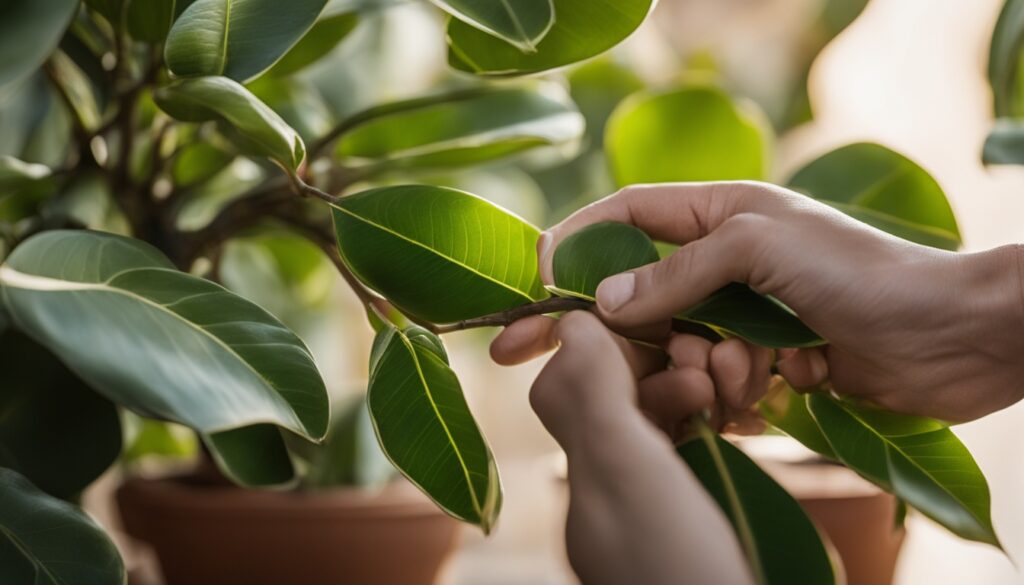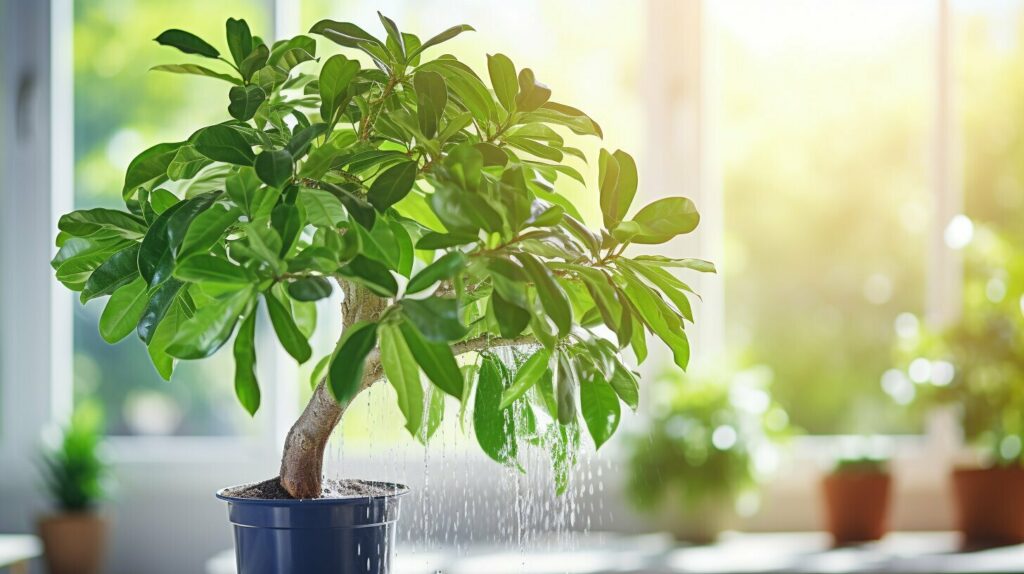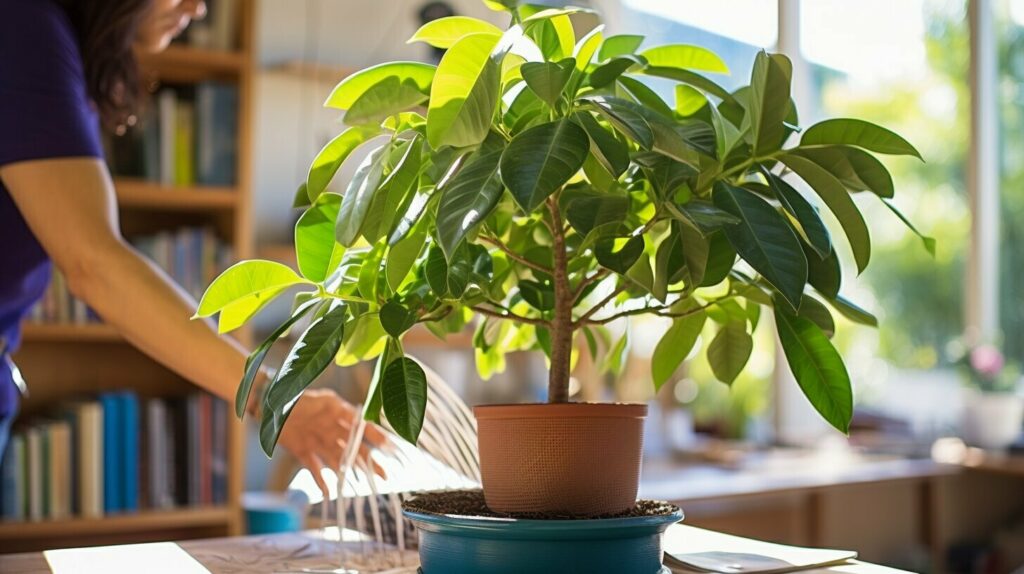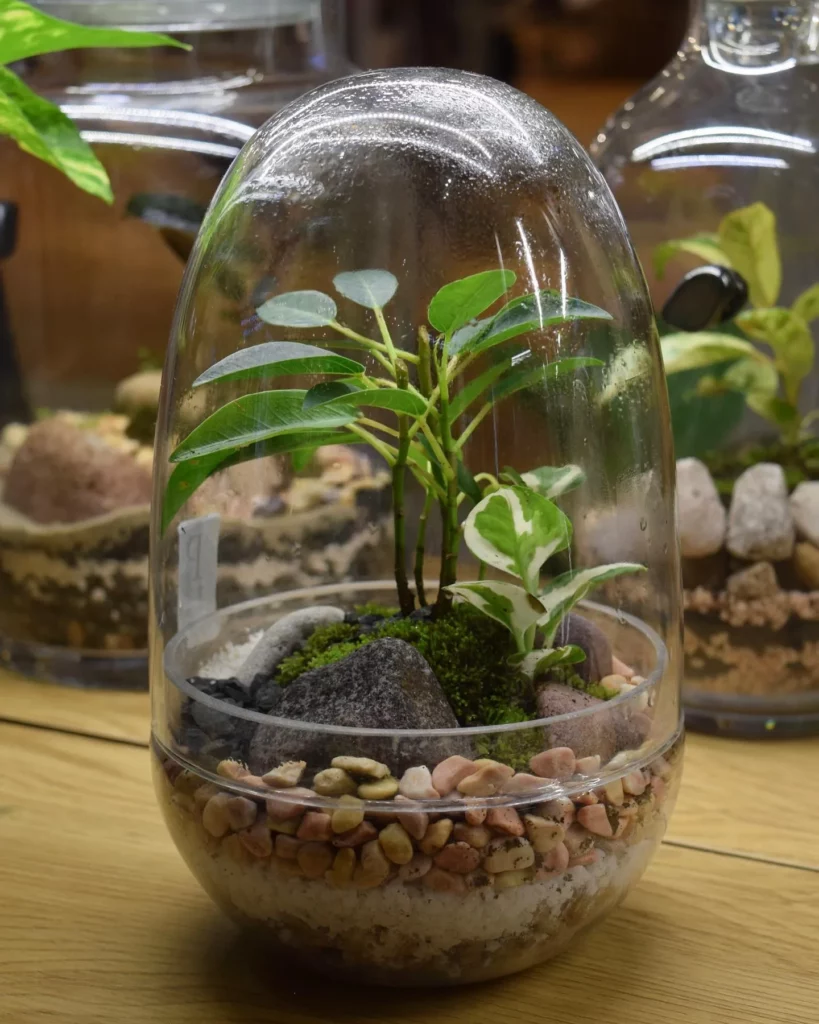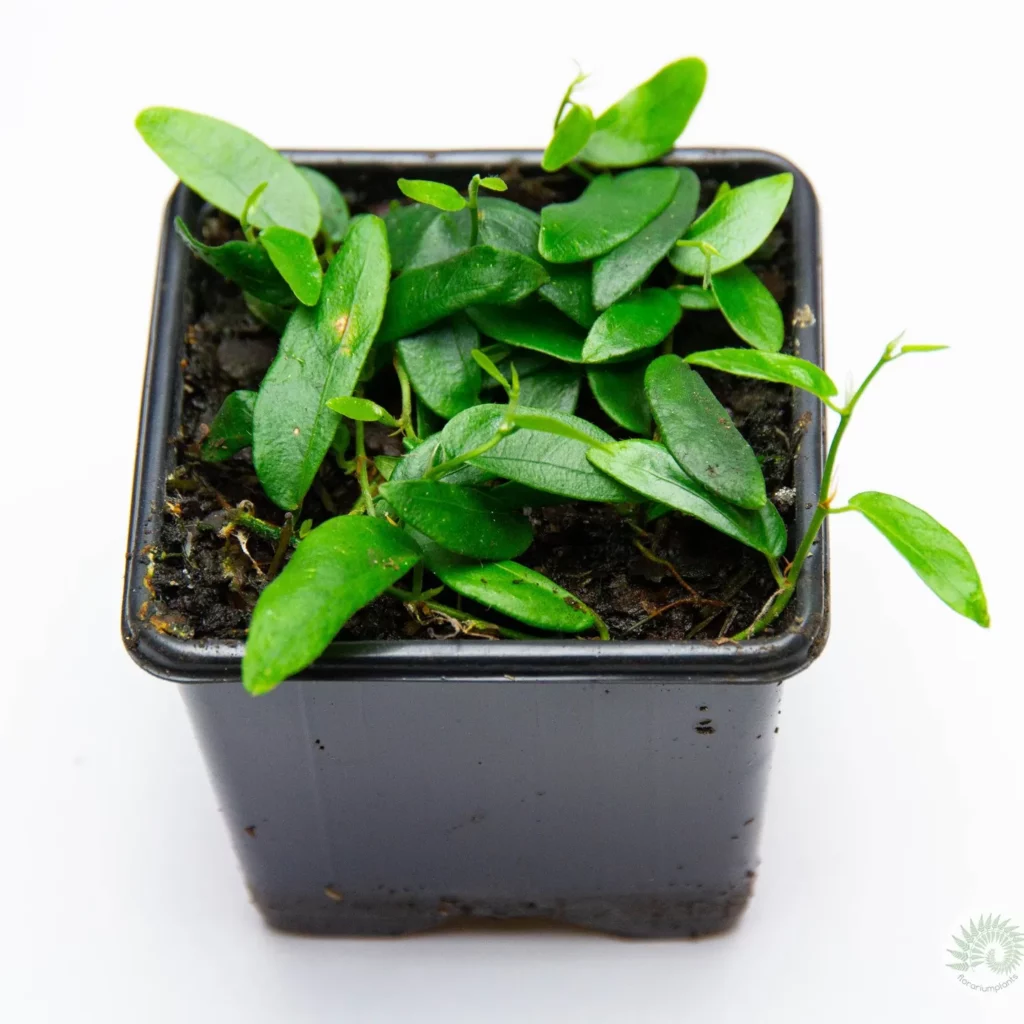The Ficus Glumosa is a tropical evergreen shrub loved as a houseplant. It’s named after its mistletoe-like, glossy leaves. These leaves have distinct lobes, making the plant eye-catching. This guide will give you all the tips for growing a beautiful Ficus Glumosa indoors.
Key Takeaways
- The Ficus Glumosa is a tropical evergreen plant native to Southeast Asia, known for its unique deltoid-shaped leaves.
- It thrives in bright, indirect sunlight and requires well-draining soil and consistent moisture.
- Proper watering, fertilization, and pruning techniques are essential for maintaining the plant’s health and appearance.
- The Ficus Glumosa is relatively easy to propagate through stem cuttings or air layering methods.
- This houseplant is generally considered safe for homes with pets when grown out of reach.
Introduction to Ficus Glumosa
The Ficus Glumosa, also called the Ficus Deltoidea or Mistletoe Rubber Plant, is a fig tree. It comes from the Moraceae family. This tropical plant grows in the lush rainforests of Southeast Asia. Locations like Malaysia, Indonesia, and the Philippines are its home.
What is Ficus Glumosa?
This plant attracts attention with its shiny, leathery leaves. They are shaped like a lobed or deltoid shape. This makes it stand out in any home. The Ficus Glumosa is loved by people who keep plants at home.
Origins and Natural Habitat
In the tropics, the Ficus Glumosa grows on other plants. It’s native to the rainy and humid forests of Southeast Asia. Its ideal home includes warm, moist air and just enough sunlight that peeks through the tree tops.
To grow the Ficus Glumosa successfully, we must create an environment like its natural one. This means it needs bright but not direct sunlight and lots of humidity. Doing this helps the plant thrive indoors.
| Plant Name | Origin | Natural Environment |
|---|---|---|
| Ficus Glumosa | Southeast Asia (Malaysia, Indonesia, Philippines) | Tropical rainforests and humid forest areas |
Ficus Glumosa Houseplant Cultivation: An Expert’s Guide
To grow the Ficus Glumosa in your home, it needs the right care. This indoor plant care guide gives you the tips and advice you need. It will help you keep this special plant flourishing indoors.
The Ficus Glumosa, known as the Mistletoe Rubber Plant, is from Southeast Asia. It has bright, lobe-shaped leaves. These make it perfect for any room. With care, it can bring natural beauty to your living space.
Light is key for the Ficus Glumosa. It loves bright, indirect light, but not direct sun. Place it near an east or west window. Or, use a south window with sheer curtains to soften the light.
| Lighting Conditions | Plant Examples |
|---|---|
| Direct Light | Cacti, Succulents |
| Indirect Light | Ficus Glumosa, Monstera Deliciosa |
| Low Light | ZZ Plant, Sansevieria |
Watering right is also vital for plant health. Too much water can harm your plant. Let the soil dry slightly between waterings. Always check if the top soil is dry before watering again.
Choosing the correct soil and pot is crucial for the Ficus Glumosa. It loves a mix that’s porous yet holds some moisture. A mix of peat moss, perlite, and bark or coco coir works well.
“The key to successful houseplant cultivation is understanding and meeting the specific needs of each plant species, from lighting and watering to soil and temperature requirements.” – Jane Smith, Certified Horticulturist
Trimming and keeping your Ficus Glumosa tidy is a must. In spring or early summer, prune with sharp scissors. Cut off dead leaves and tips. This helps the plant grow fuller and keeps it in shape.
- Provide bright, indirect light
- Water thoroughly, allowing soil to dry slightly between waterings
- Use a well-draining, nutrient-rich potting mix
- Prune and groom regularly to maintain shape and promote healthy growth
Follow these expert advice and houseplant cultivation tips. Doing so will make your Ficus Glumosa a highlight in your home.
Light Requirements for Ficus Glumosa
For Ficus Glumosa to grow well, it needs the right indoor plant lighting. This plant loves bright indirect sunlight, similar to its wild home under the forest’s cover.
Understanding Light Needs
The Ficus Glumosa light requirements are precise for its health and growth. Too much direct light can burn its leaves, causing damage. In nature, it’s used to getting shades of light from tall trees above.
Ideal Lighting Conditions
There are several good ways to light your Ficus Glumosa at home.
- An east or west window with bright indirect sunlight is best.
- If your window faces south, keep the plant out of direct sun. Use thin curtains to soften the light.
- You can also use special lights to make up for any lack of natural light. Grow lights or LED bulbs work well.
With the right Ficus Glumosa light requirements, your plant will flourish. It will have healthy leaves and bring a tropical feel to your home.
Watering Ficus Glumosa
It’s vital to water your Ficus Glumosa plant correctly. This tropical green resident doesn’t like too much or too little water. So, finding the right amount is key.
Signs of Underwatering
Worried your plant has too little water? Look for leaves that are wilting, curling, or drooping. If the soil is dry and crumbly, it’s probably thirsty.
Signs of Overwatering
Too much water is bad news too. Watch for yellow leaves, and check if the soil is soggy. Over time, wet roots can cause rot, harming your plant.
Proper Watering Techniques
To water your Ficus Glumosa right, use these steps:
- Water the plant deeply, but let the soil slightly dry out between waterings. The top inch or two of soil should dry before you water again.
- Keep the soil moist, but don’t let the plant stand in water.
- Always check the soil by sticking your finger in. If it’s dry an inch down, it’s time to water.
Using these methods will help keep your Ficus Glumosa healthy. It’s a good way to prevent watering problems.
Don’t forget, your plant likes consistent moisture and a potting mix that drains well. This will make your Ficus Glumosa thrive.
Soil and Potting Mix
The Ficus Glumosa plant loves a well-draining potting mix. This mix should not only let air through but also hold some water. You should use a blend of organic and inorganic materials to meet its soil requirements.
Ideal Soil Composition
Here’s a recipe for an ideal potting mix for your Ficus Glumosa:
- Peat moss or coco coir for moisture retention
- Perlite or coarse sand for drainage
- Bark chips or vermiculite for aeration
This mix keeps moisture in but lets extra water out. That’s important for avoiding root rot and other water damage.
Repotting Guidelines
Your Ficus Glumosa should be repotted every 2-3 years. This helps its roots spread and gives it fresh nutrients. Here’s how to do it:
- Take the plant out of its old pot carefully, without hurting the roots.
- Get a slightly bigger pot than before, and make sure it has holes in the bottom for water to escape.
- Put the well-draining potting mix you’ve prepared into the new pot.
- Place the plant in the new pot, making sure it sits at the same depth as before.
- Press the soil lightly around the base of the plant and water it well.
Doing this every few years gives your Ficus Glumosa enough room and nutrients to keep growing strong.
| Potting Mix Components | Purpose |
|---|---|
| Peat moss or coco coir | Moisture retention |
| Perlite or coarse sand | Drainage |
| Bark chips or vermiculite | Aeration |
Temperature and Humidity
The Ficus Glumosa loves warm temperatures, between 65°F and 85°F (18°C to 29°C). This is typical for a tropical plant environment. It adjusts well to the usual humidity levels found in homes. But, it does even better with more moisture.
To boost humidity, mist the leaves often. You can also use a pebble tray under the plant. Another good idea is to put a humidifier close by. These steps can help the plant stay healthy and avoid problems like browning leaves.
Optimal Temperature Range
This plant does best in temperatures similar to its tropical home. That’s about 65°F to 85°F (18°C to 29°C) indoors. Keeping it warm helps the Ficus Glumosa grow well and look beautiful.
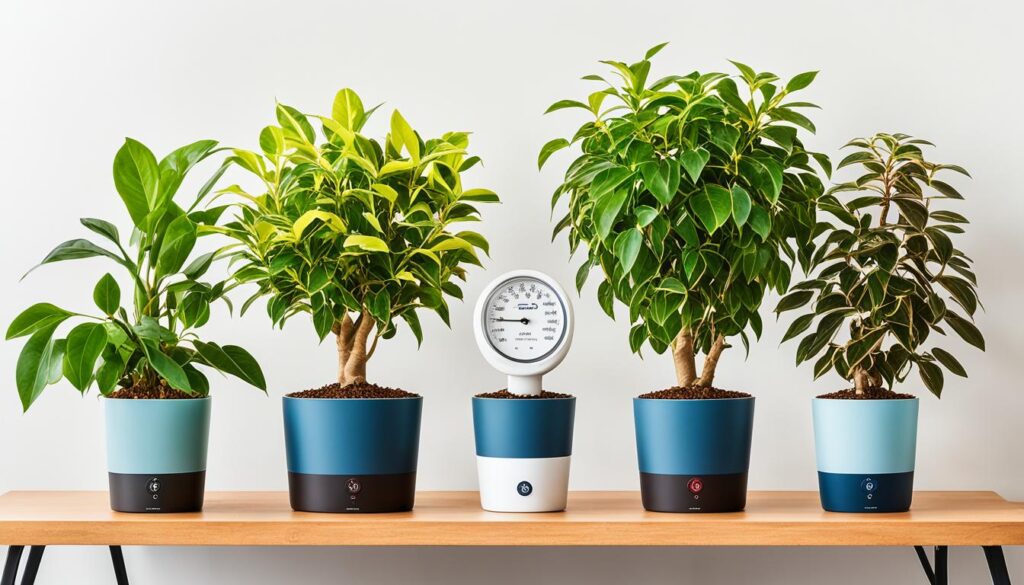
It can handle a little cold or heat, but not for long. Temps under 60°F (15°C) or over 90°F (32°C) stress the plant. This can slow its growth, make its leaves fall, or attract pests.
Humidity Needs
The Ficus Glumosa comes from a place with a lot of moisture. It’s used to lots of humidity. While it manages in average home humidity, it loves more.
There are many ways to add humidity around your plant:
- Misting the leaves regularly with a spray bottle
- Placing the plant on a pebble tray filled with water
- Using a humidifier near the plant
- Grouping plants together to create a microclimate
Keeping humidity up creates an ideal tropical plant environment. This means your Ficus Glumosa can thrive with green, healthy leaves.
Fertilizing Your Ficus Glumosa
Fertilizing your Ficus Glumosa right is key to its health. The plant loves the right nutrients during spring to fall, its active growing season. Knowing what it needs and when to feed it helps your plant grow strong.
Fertilizer Types
A balanced fertilizer is best for your Ficus Glumosa. Aim for a water-soluble kind with equal parts of nitrogen, phosphorus, and potassium. A 20-20-20 or 10-10-10 mix is perfect for growth and health.
You could also try slow-release or organic options. These fertilizers are easy because you don’t have to use them as often. Just make sure to read the label for the best way to use them.
Fertilizing Schedule
Fertilize your plant every 4 to 6 weeks when it’s growing actively. But, use only half the strength of the fertilizer. This keeps the soil healthy for your plant.
Always water your plant well before adding the fertilizer. Don’t feed it in winter since it doesn’t need much then. This helps avoid giving the plant too much and causing issues.
| Time of Year | Fertilizing Frequency | Fertilizer Strength |
|---|---|---|
| Spring to Fall | Every 4-6 weeks | Half-strength |
| Winter | No fertilization | – |
Too much fertilizer is bad news for your plant. Stick to the directions on the package to keep your Ficus Glumosa happy and healthy. This avoids damaging your plant with too many nutrients.
Pruning and Grooming
Proper pruning and grooming keep your Ficus Glumosa healthy and beautiful. Use the right pruning tips and shaping techniques. This will help your plant grow well and look good. It also gets rid of dead leaves.
When to Prune
The best time to prune your Ficus Glumosa is in the spring or early summer. This is when it’s growing a lot and putting out new leaves. Pruning then helps it bounce back fast and grow even better.
Pruning Techniques
Use sharp, clean shears to cut off any dead or ugly parts. After, shape your plant how you want. Trimming the tips makes it fill out more. And cutting some stems makes it look the way you like.
Gently take off the dead leaves. Don’t pull on them too hard. The Ficus Glumosa might ooze sap if you’re too rough. Always take off dead leaves a little at a time.
Pruning your plant regularly does more than make it look good. It also lets air and light reach inside. This makes your plant stronger and avoids sickness or bugs.
| Pruning Frequency | Pruning Goals | Pruning Methods |
|---|---|---|
| Every 2-3 months | Shape and control size | Pinching, selective stem pruning |
| Annually (spring/early summer) | Remove dead or damaged growth | Careful snipping of affected areas |
| As needed | Maintain desired form | Shaping, thinning, and trimming |
With the best pruning tips and care, your Ficus Glumosa will do well. It will stay pretty and green for many years.
Common Problems and Solutions
The Ficus Glumosa is tough but faces issues like pest infestations, fungal diseases, and environmental stress factors. It’s key to act fast to keep your plant healthy. Below, you’ll find simple ways to spot and tackle these problems.
Pest Infestations
Indoor plants like the Ficus Glumosa might attract pests. This includes spider mites, mealybugs, and scale insects. They can harm your plant by feeding on its sap. This leads to yellow leaves, wilting, and growth problems. Always check the plant’s undersides and joints for these pests.
If you find pests, act quickly. Insecticidal soap or neem oil works well for treating them. Make sure to thoroughly spray the plant, including the underside of leaves. Repeat as needed, following the product instructions.
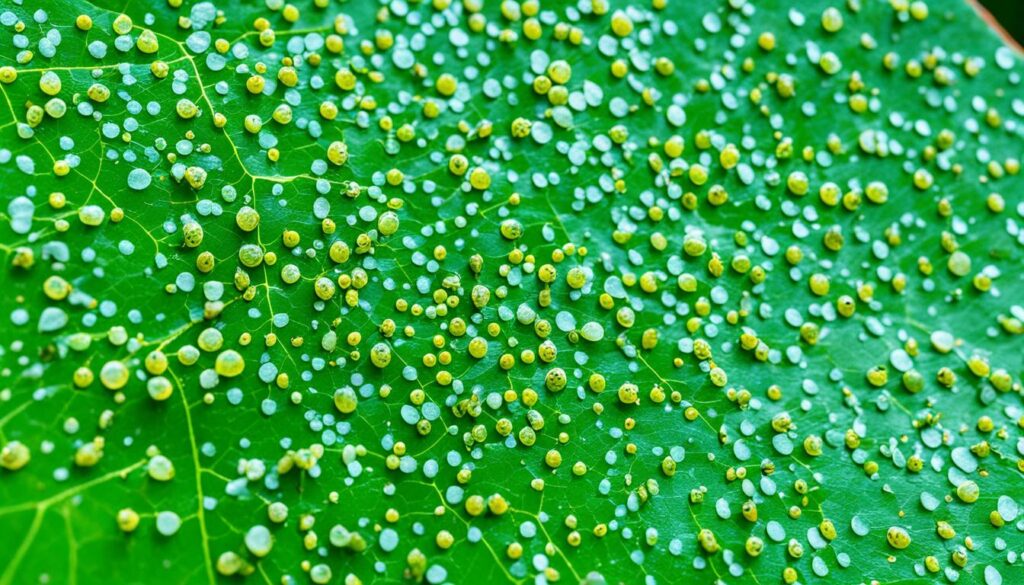
Disease Issues
Too much water can bring fungal diseases to the Ficus Glumosa. Signs may include brown or yellow spots on leaves (leaf spot), and wilting or death from root rot. Using well-draining soil and watering correctly can help prevent these diseases.
Isolate an infected plant and improve air flow around it. Remove any damaged leaves or stems with clean scissors. You might also want to use a fungicide. In severe cases, repotting into fresh, sterile soil can save the plant.
Environmental Stress
The Ficus Glumosa can suffer if its growing conditions are wrong. Not enough light can turn leaves brown and make them fall. And cold drafts cause stress, leading to leaf loss.
To avoid stress, give the plant enough light, warmth, and humidity. Keep it away from drafts and extreme temperature changes. This care will help the Ficus Glumosa stay healthy.
| Problem | Cause | Solution |
|---|---|---|
| Leaf drop | Inconsistent watering, low humidity, drafts | Maintain consistent soil moisture, increase humidity, relocate away from drafts |
| Yellowing leaves | Overwatering, poor drainage, nutrient deficiency | Adjust watering schedule, improve drainage, fertilize appropriately |
| Stunted growth | Insufficient light, low temperatures, pest infestation | Increase light exposure, maintain warm temperatures, treat pests |
To keep your Ficus Glumosa healthy and green, be alert and act fast. With regular checks and good care, you can stop small problems before they grow big.
Propagating Ficus Glumosa
The Ficus Glumosa is an easy-to-care-for houseplant. You can make new plants from it by taking stem cuttings or using the air layering method. This ensures you can keep enjoying the beauty of this tropical fig plant.
Stem Cuttings
Starting new plants from a Ficus Glumosa is simple. First, pick a healthy stem and cut a 4-6 inch piece off. After that, strip off the lower leaves and then put the end in rooting hormone powder. This powder helps with quicker root growth.
Next, plant the cutting in good soil and water it well. Make sure to keep the soil damp and warm. Soon, you’ll see new roots.
Air Layering
Air layering is also great for making more plants. For this, make a small cut on the stem of the parent plant. Then, dust this cut with rooting hormone. Wrap that spot in moist sphagnum moss and hold it in place with plastic or foil.
Keep the moss wet and roots will start to grow. When there are enough roots, you can separate this part and plant it in its own pot.
For both methods, keep the conditions right for roots to develop. That means keeping the area warm, moist, and with bright but not direct sunlight. This way, you can soon fill your home with more Ficus Glumosas.
Toxicity and Pet Safety
The Ficus Glumosa is seen as a pet-friendly houseplant. It’s a good pick for homes with pets. Yet, it’s crucial to stop pets from eating it. Eating this plant can upset their stomach.
Keeping pets safe from this plant’s leaves or stems is very important. Put the Ficus Glumosa where pets can’t get to it. This way, your home can be safe for pets and plants to live together.
The Ficus Glumosa is safe for pets if they can’t reach it. But, it’s still smart to watch how pets and plants interact. Being careful and keeping an eye on things can protect your pets.
| Plant | Toxicity Level | Pet Safety |
|---|---|---|
| Ficus Glumosa | Non-toxic to humans | Safe for homes with pets when kept out of reach |
| Calathea | Toxic | Potentially harmful to pets |
| Sansevieria | Non-toxic | Safe for homes with pets |
As plant lovers, we need to know the risks different plants pose. This is especially true when we care for our pets. Learn and take steps to keep everyone safe. This makes a happy home for both plants and pets.
Conclusion
The Ficus Glumosa is perfect for indoor environments. It adds beauty to any houseplant collection. Keep it in bright light and water it often. This way, your home will look more tropical. Caring for it right will make it stand out.
To keep your Ficus Glumosa healthy, give it regular care. Cut it back to help it grow into a full shape. Feed it when it’s growing lots. Watch out for pests and diseases, fixing them fast. By doing these steps, you can grow a strong and beautiful plant.
Taking care and being patient with the Ficus Glumosa pays off. It’s special because it looks great indoors. It’s the perfect choice for homes or offices. Enjoy the process of indoor gardening and see this plant flourish thanks to your hard work.

